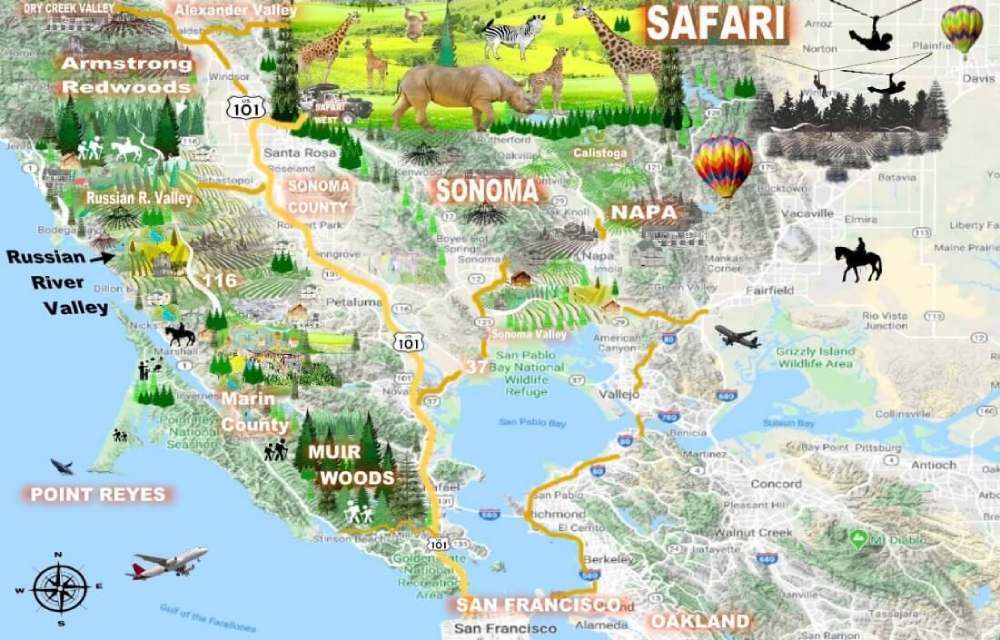Stinson Beach State Park and Seaside Village

Stinson Beach is about a 40-minute drive from the Golden Gate Bridge on California’s Pacific Highway 1. It is near excellent attractions such as Muir Woods National Monument, Point Reyes , Bolinas, Muir Beach Overlook, Muir Beach, and Mount Tamalpais. The beach is one of the cleanest in the state, and sandy, unlike the rockier neighboring beach in Bolinas.
Stinson Beach is a popular day trip for local who live in the in the San Francisco Bay Area , but also for tourists. Although most visitors arrive by private car, Stinson Beach is linked to Marin City by a daily bus service, and the network of hiking trails around Mount Tamalpais also reaches the town.
Many notable famous people fell in love with Stinson beach’s beauty, calling it home, including Senator Dianne Feinstein, Steve Miller, Jerry Garcia, and David Grisman.
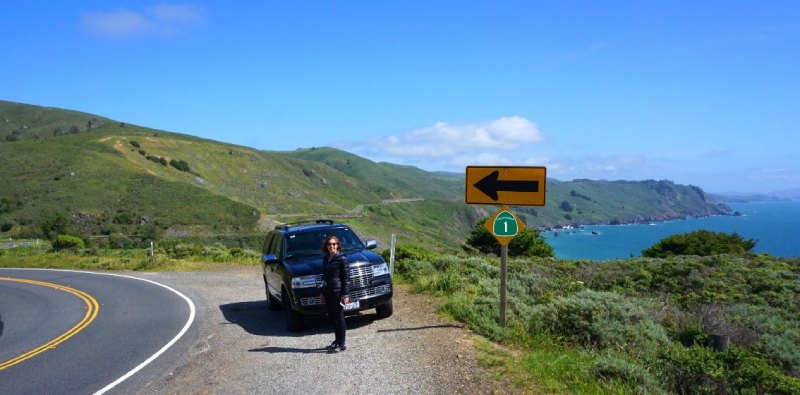
Did you know that the dramatic scenery of Stinson Beach was the setting for movies including “Memoirs of an Invisible Man,” “Basic Instinct,” “Play It Again Sam,” “The Fog,” “Shoot the Moon,” and “On the Edge?”
Brief history: In 1870, the first road was built along the Pacific coast from Sausalito, California, and a tent settlement sprang up amongst the willow trees at the beach, which gave rise to the town’s original name, Willow Camp. The Mt. Tamalpais & Muir Woods Railway opened in 1896, making Willow Camp more accessible. Visitors could ride the train to West Point Inn and then hike or arrange a stagecoach to take them to the beach. In 1906, refugees from the San Francisco earthquake came to the area and built some of the area’s first businesses. Stinson Beach became the official town name in 1916, in honor of the largest landowners, Rose and Nathan Stinson.
In 1939, the beach was sold to Marin County. It was transferred to the State of California in 1950 and was eventually transferred to the National Park Service in 1977.

In 2002, a surfer was attacked by a 12-to-15-foot-long (3.7 to 4.6 m) great white shark while surfing off Stinson Beach. The young man survived but received more than 100 stitches to close his wounds. The attack was the second in Stinson Beach, and the 13th in Marin County since 1952. In 1998, Jonathan Kathrein was attacked by a great white shark while bodyboarding. His injury from the shark bite required over 600 stitches. The surf off Stinson Beach is within an area known as the Red Triangle, where there have been an unusually high number of sharks’ attacks.
The small coastal town of Bolinas
The small coastal town of Bolinas is located off Highway 1, a few miles north of Stinson Beach, surrounded by the Pacific Ocean, beautiful lagoons, and wetlands. The trough in which the lagoon sits was formed by the San Andreas Fault, which runs through it. The lagoon is separated from the main bay by a small spit of land and is a tidal estuary, which is part of the Gulf of the Farallones National Marine Sanctuary.
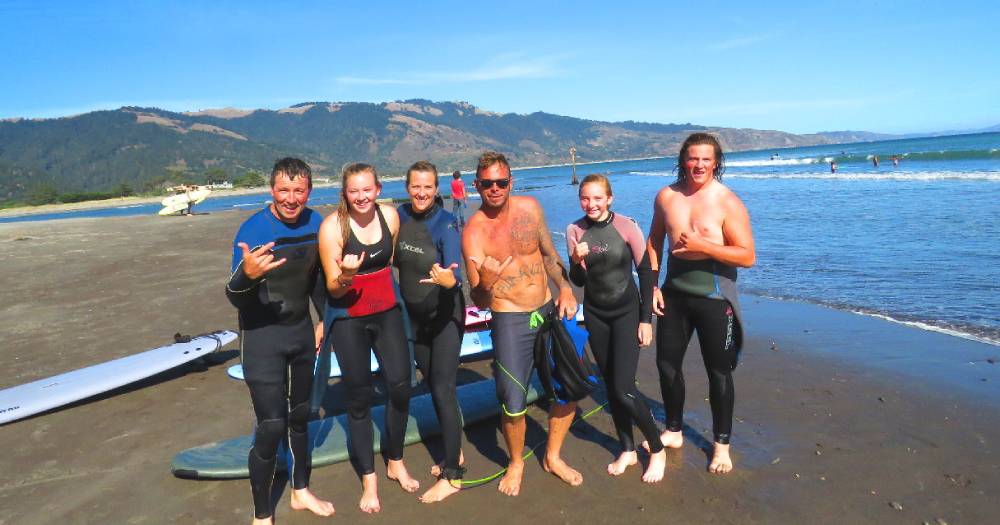
Bolinas is known for its reclusive residents and is only accessible by unmarked roads. In the past, road signs were torn down to help this area remain off-the-beaten-path. Discover the town’s natural beauty, from bird watching to surfing where you may have surf lessons as well.
Bolinas is a hidden gem and small beach town that featured in the 1981 novel “Ecotopia Emerging,” by Ernest Callen Bach. It is also the mythical setting for Richard Brautigan’s novel “In.” Bolinas has a long history of environmentalism and is characterized by its free-spirited community of surfers, actors, poets, artists, and writers.

The visitors who make it to Bolinas appreciate its earthy custom-built homes and shingled New England-styled cottages with colorful gardens.
Fun facts: Did you know Bolinas’ post office and some of Bolinas’ houses were constructed during the Gold Rush era?
Alice Waters is also a resident. She is an American chef and owner of “Chez Panisse,” the world-renowned restaurant in Berkeley, famous for its organic, locally grown ingredients and as the birthplace of Californian cuisine.

Tucked in the foothills of Mount Tamalpais, the charming village of Muir Woods Beach is a romantic and cozy getaway for locals. Muir Beach is a quiet sheltered cove located on the Pacific Coast three miles west of Muir Woods National Monument, between Stinson Beach the Golden Gate Bridge. Muir Beach and lagoon favored by locals. Muir. The beach is accessed over a 450-foot-long pedestrian bridge that connects the parking lot to the beach, the Coastal Trail, and Kaashi Way, which is multi-use and accessible.
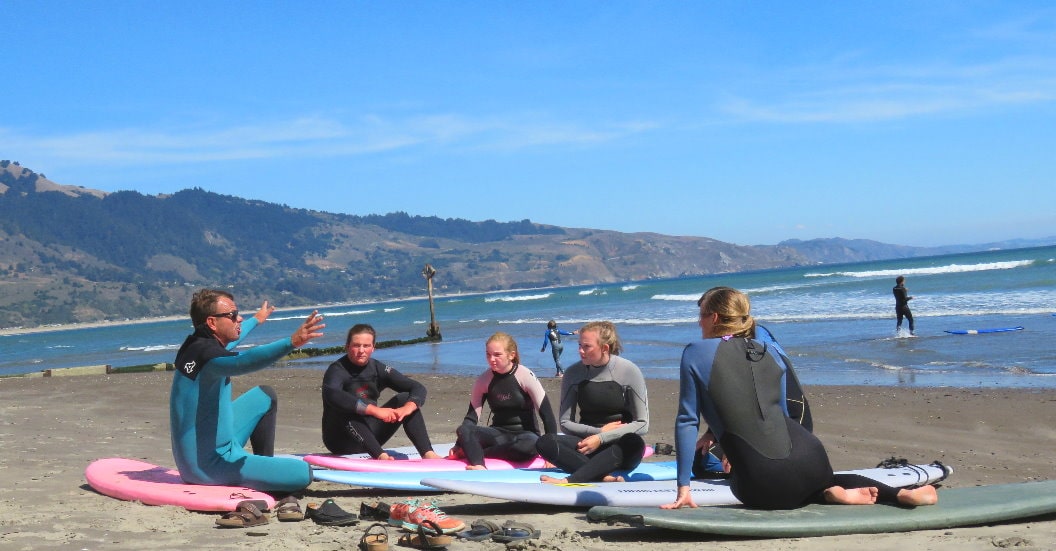
Muir Beach Redwood Creek and Lagoon and surrounding riparian area provide critical habitat for coho salmon and red-legged frogs and is closed to all access. Also, every autumn thousands of monarch butterflies (Danaus plexippus) embark on a once-in-a-lifetime migration to the California coast. Wintering monarchs can sometimes be found decorating Monterey pines in the small grove at Muir Beach; look for their distinctive orange and black wings.

There is a small free parking lot at Muir Beach but extremely limited. Large vehicles as well as commercial vehicles are not allowed without permits and advanced reservations. Muir Beach offers one of the most enjoyable hikes and trails in the Marin County with spectacular ocean views of San Francisco and the Ocean. The Pelican Inn at Muir Beach opens its doors to you for the fellowship of its Tudor bar and country cooking.
Tips for visitors- Beach Fire Information:
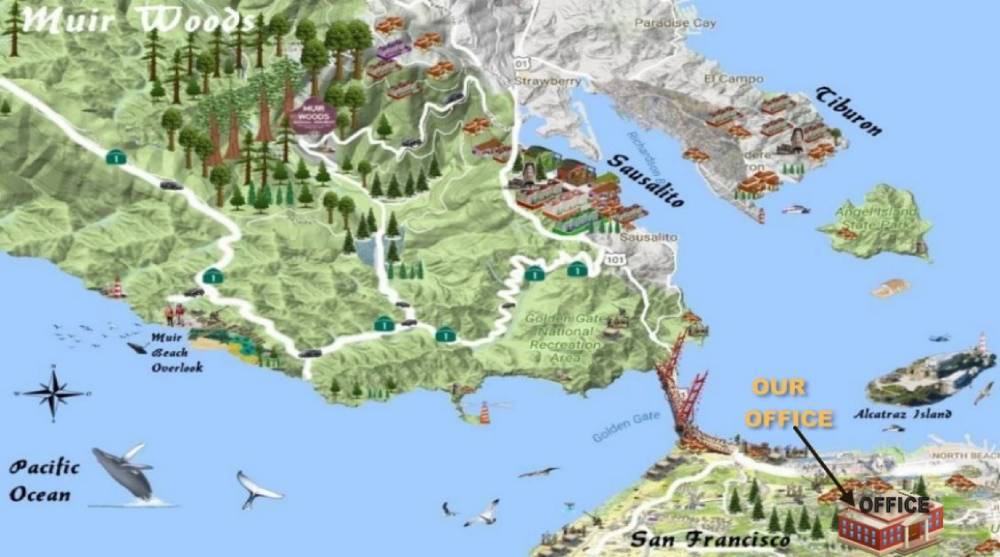
-Groups of more than 25 people must obtain a permit by calling (415) 561-4700. For more information visit https://www.nps.gov/goga/planyourvisit/permits.htm
-Dogs are allowed on the beach but must be either on-leash or under “Voice Control”, meaning dogs are within earshot and eyesight of their owner/handler and respond immediately to commands to return to a leash when called.
-The northernmost end of the beach is popular with clothing-optional sunbathers.
-Always watch the waves. There are no lifeguards at Muir Beach.
– Fires allowed only in provided fire rings beginning at 9 AM and must be extinguished and groups must vacate the beach by 1-hour after sunset. Fire rings are available on a first-come first-serve basis. Six fire rings are available May through November. Three fire rings are available December through April.
Fires must be extinguished with WATER ONLY. Bring a bucket to collect ocean water or bring your own water. Covering the fire with sand does not extinguish the fire. Instead, it insulates the hot coals and fills the pits with sand.Hiking: Muir Beach to Tennessee Beach Loop is the most popular hike, it’s about 8.5 mile moderately trafficked trail which starts at the Tennessee Valley trailhead and crosses over Coyote Ridge to reach Muir Beach.
Brief history: Muir Beach is part of the Golden Gate National Recreation Area. Unlike Muir Woods National Monument, the beach and town were not named in honor of conservationist John Muir; instead, it was named after Muir Woods National Monument to capitalize on the latter’s popularity. The community itself flanks the northwest side of the beach. The Redwood Creek empties into the beach. There is a parking lot at the beach, which is accessible via a footbridge.
The beach was formerly called Big Lagoon after a freshwater lagoon that was located where the parking lot is now. Damage from 20th century dairy farms interfered with the flow of the creek and the lagoon.
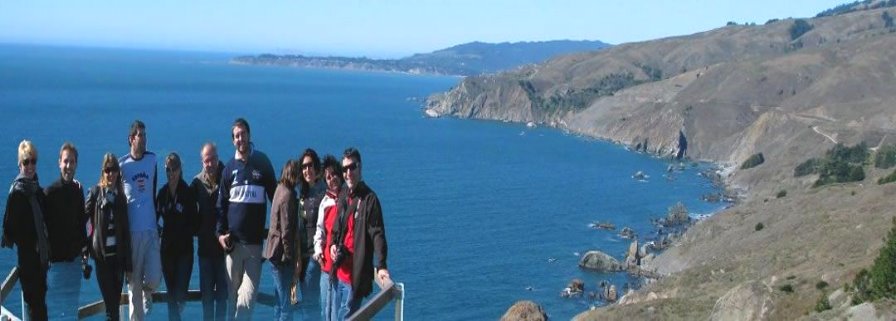
Muir Beach Overlook: Muir Beach Overlook is rocky point that sits atop rugged steep cliffs overlooking Muir Beach, San Francisco, Bolinas, and Mount Tamalpais. This small park is part of the Golden Gate National Recreation Area located on State Route 1 between Sausalito and Stinson Beach.
Take the short hiking trail to a cliff-top lookout to enjoy a panoramic and sweeping views of the Marin coast, and Muir Beach.
The cliff plunges over 200 feet to the rocky surf. Nearby you can visit Slide Ranch and its animal farm, and below that, a tidal reef loaded with small crabs.
Brief history: Muir Beach overlook observation bunkers were built during the Second World War as part of the American coastal defense of California against the threat of Pacific invasions. This was a military outpost.
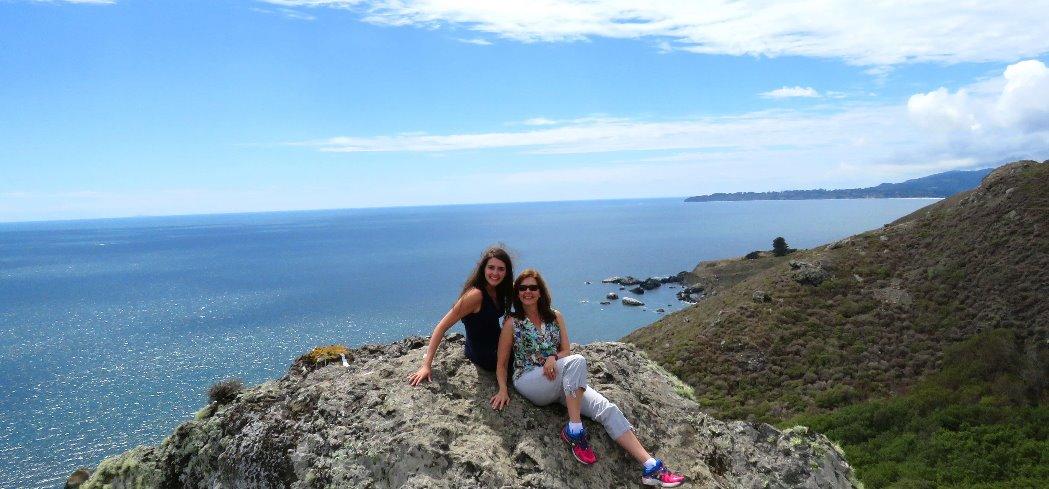
Muir Beach Bunkers contain several historic base-end stations. From these stations, soldiers viewed ships and triangulated the distance, speed, and direction of these ships in coordination with different stations. These stations were mostly important for artillery units stationed on the coast to attack any invasion. They gained particular importance during World War II immediately after the bombing of Pearl Harbor when many in California feared San Francisco or Los Angeles would be the next target. With the advent of radar and its widespread use, these stations became obsolete.
Today, a few of them remain open like ruins where you may enter them to get somewhat of a perspective of the soldiers who were therein stationed.

Nearby attractions and things to see. Nearby, you can visit Muir Woods forest of old redwoods, Muir Beach, Stinson Beach, Bolinas, Mill Valley and Mount Tamalpais. You may also checkout the Slide Ranch and its animal farm. The Slide Ranch Beach is a non-profit farm for education that is situated on national park property north of Muir Beach Overlook. The mission of Slide Ranch is to connect children to nature, and to cultivate healthy bodies and minds and foster future generations of environmental stewards.
